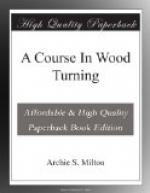SPEED OF THE LATHE
The speed of the lathe should range from 2400 to 3000 revolutions per minute when the belt is on the smallest step of the cone pulley. At this speed stock up to 3” in diameter can be turned with safety. Stock from 3” to 6” in diameter should be turned on the second or third step, and all stock over 6” on the last step. The speed at which a lathe should run depends entirely upon the nature of the work to be done and the kind of material used. Pieces that cannot be centered accurately and all glued-up work with rough corners should be run slowly until all corners are taken off and the stock runs true. At high speed the centrificial force on such pieces is very great, causing the lathe to vibrate, and there is a possibility of the piece being thrown from the lathe thus endangering the worker as well as those around him. After the stock is running true the speed may be increased.
[Illustration: Fig. 1. — Wood Turning Lathe]
TO FIGURE THE DIAMETER OF PULLEYS
Suppose a motor runs 1500 R.P.M. and is fitted with a 4” pulley. Suppose also, a main shaft should run 300 R.P.M.
Then, 1500 : 300 :: x :
4;
Or, 300x = 6000,
x = 20, or the
diameter of the large pulley on the main shaft.
Suppose again that a line shaft runs 300 R.P.M., and a counter shaft 600 R.P.M. The counter shaft has a pulley 4” in diameter. The pulley on the line shaft must then have a diameter of 8”.
300 : 600 :: 4 : x;
Or, 300x = 2400,
x = 8”
Suppose the cone pulley on the counter shaft runs 600 R.P.M.; a lathe spindle runs 2200 R.P.M., when connected with the small cone pulley which has a diameter of 3”. The large cone pulley has then a diameter of 11”.
600 : 2200 :: 3 : x
Or, 600x = 6600;
x = 11”
RULES FOR FINDING THE SPEEDS AND SIZES OF PULLEYS
1. To find the diameter of the driving pulley:
Multiply the diameter of the driven by the number of revolutions it should make and divide the product by the number of revolutions of the driver. (20 x 300 = 6000; 6000 / 1500 = 4”—diameter of motor pulley.)
2. To find the diameter of the driven pulley:
Multiply the diameter of the driver by its number of revolutions and divide the product by the number of revolutions of the driven. (4 x 1500 = 6000; 6000 / 300 = 20”—diameter of the driven pulley.)
3. To find the number of revolutions of the driven pulley:
Multiply the diameter of the driver by its number of revolutions and divide by the diameter of the driven. (4 x 1500 = 6000; 6000 / 20 = 300—revolutions of driven pulley.)




